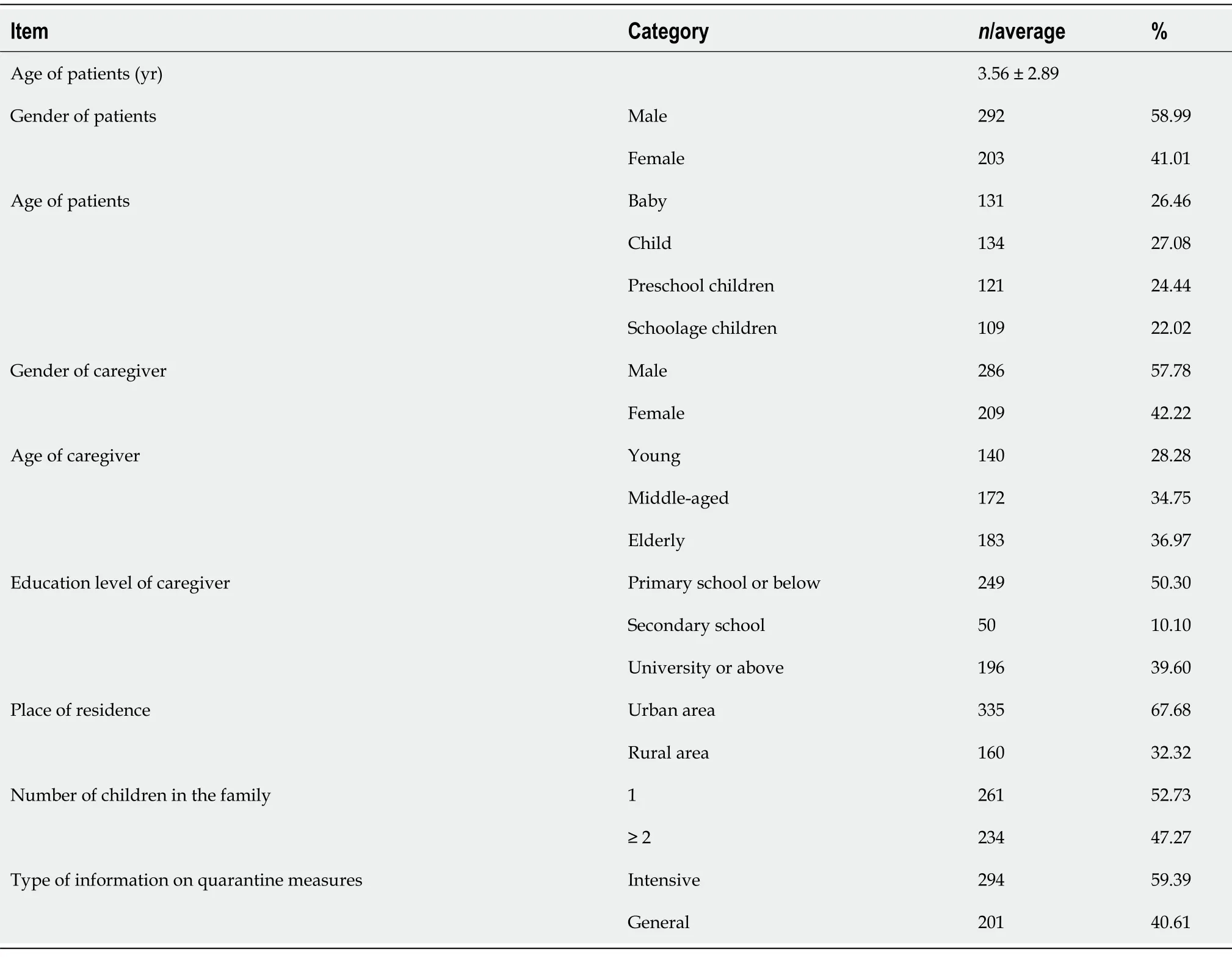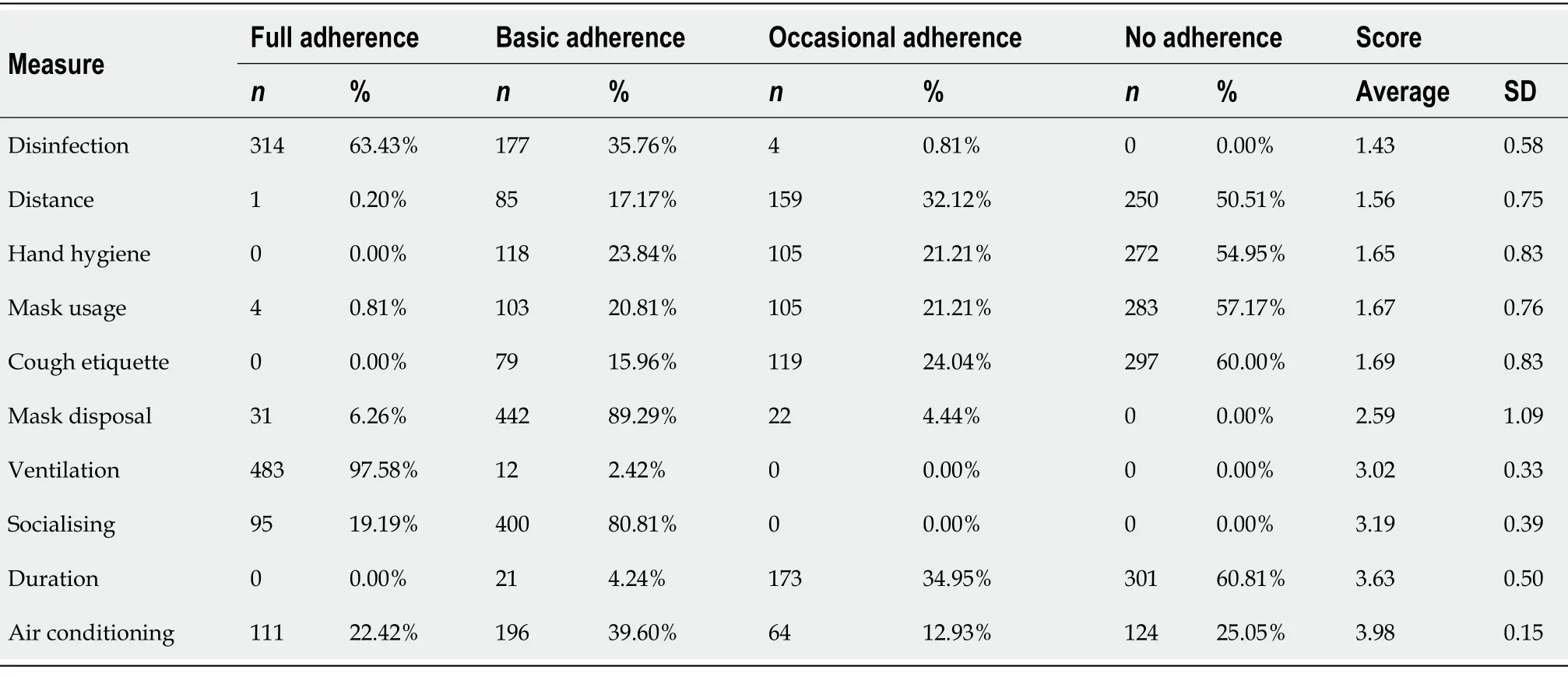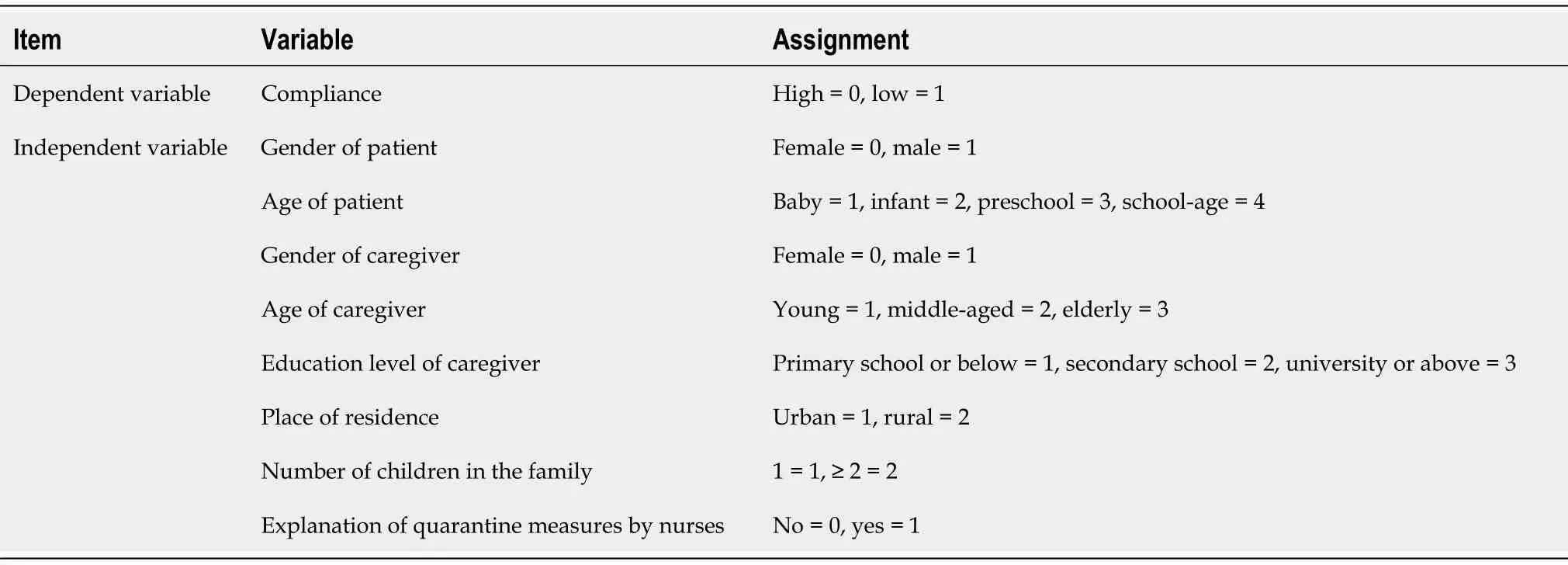Home quarantine compliance is low in children with fever during COVID-19 epidemic
2020-09-16QingLouDeQuanSuSunQinWangGaoLianQiaoLiZhiQiangZhuo
Qing Lou,De-Quan Su,Sun-Qin Wang,E Gao,Lian-Qiao Li,Zhi-Qiang Zhuo
Qing Lou,Sun-Qin Wang,E Gao,Lian-Qiao Li,Department of Emergency Medicine,Xiamen Children’s Hospital,Xiamen 361006,Fujian Province,China
De-Quan Su,Zhi-Qiang Zhuo,Department of Infections,Xiamen Children’s Hospital,Xiamen 361006,Fujian Province,China
Abstract
Key words:COVID-19;Fever;Children;Home quarantine;Compliance;Influence factor
INTRODUCTION
The coronavirus disease 2019 (COVID-19) has spread across the world,seriously affecting health and the development of a global society and economy[1,2].Reducing the people flow and cutting off the transmission routes are of great significance for the prevention and control of the COVID-19 epidemic.The “Guidelines for Public Protection of Novel Coronavirus Infected Pneumonia”[3],“Guidelines for the Prevention and Control of Infection in Domestic Isolated Medical Observation in New Coronavirus Infection”[4],“The Recommendations of Experts in the Management of Integrated Traditional Chinese and Western Medicine for Patients with Fever at Home”[5],and other documents issued by the Chinese National Health Commission emphasise that patients with fever need to be isolated at home during the COVID-19 outbreak.However,there are no reports on the compliance to home quarantine measures in these patients,especially in children.In this study,we studied the compliance of children with fever to home quarantine measures and examined factors that influenced this to provide reference for better implementation of home quarantine measures.
MATERIALS AND METHODS
Study design
Paediatric patients admitted to the general fever clinic at Xiamen Children’s Hospital from February 6-27,2020 were selected for this study.The inclusion criteria were:(1)Respiratory tract infection with body temperature over 37.3°C;(2) Mild disease that can be treated at home;(3) Fever without an epidemiological history of COVID-19 or fitting clinical diagnostic criteria for suspected COVID-19 cases[1];and (4) informed of quarantine measures (general or intensive).General information was defined as a written notification of the quarantine measures whereas intensive information included explanation and demonstration by nurses.Patients were excluded based on the following criteria:(1) Unwilling to cooperate with the investigation;(2)Hospitalised within 7 d after first diagnosis;and (3) Failure to complete the survey after three telephone interviews.Our study was approved by the Xiamen Children’sHospital ethics committee and all patients provided informed consent.
Data collection
The subjects who met the inclusion criteria were surveyed by trained medical staff on the 8th day after the hospital visit.The questionnaire consisted of three parts:General data,prevention and control measures of home quarantine,and compliance scale.We collected demographic data from the family of the study subject,including the gender and age of the patient,the gender,age,and education level of the primary caregiver,the place of residence,and the number of children in the family.The home quarantine measures as recommended by the Chinese National Center for Disease Control and Prevention are shown in Table 1.
According to the above prevention and control measures,the compliance scale of home quarantine was formulated.A Likert 4-point scale was used to assess adherence to each measure[6]:1 = no adherence,2 = occasional adherence,3 = basic adherence,and 4 = full adherence.
Data analysis
The questionnaire was evaluated and SPSS 21.0 was used for statistical analyses.Numerical data are expressed as the mean ± SD and counting data are described by frequencies and percentages.Since compliance score was not normally distributed,we categorised the patients into two groups:High-compliance (score ≥ 24) and lowcompliance groups (score <24).χ2test and multivariate logistic regression were used to analyse the factors influencing home quarantine compliance in children.
RESULTS
Study subject demographics
We recruited 495 paediatric patients,82 of whom did not cooperate with the follow-up and 19 were excluded due to hospitalisation within 7 d after the first diagnosis.Therefore,we included a total of 495 in the final analysis.The average age was 3.56 ±2.89 years (range,3 mo-13 years).The demographic data are shown in Table 2.
Compliance to quarantine measures at home
We scored the compliance level to ten quarantine measures.Measures that scored highly were no use of air conditioning,continuous home quarantine for 7 d,and no gathering.However,proper disinfection,keeping 1.5 meters distance,proper hand hygiene,cough etiquette,and wearing masks at home were not well adhered to.The proportion of families showing at least basic adherence to these measures was less than 30% (Table 3).
Factors that influence compliance to home quarantine measures
Our analysis showed that home quarantine compliance was related to gender and age of the patients,gender and age of primary caregivers,number of children in the family,and how the family was informed of quarantine measures.Compliance of families with girls was significantly higher than those with boys (χ2=9.681,P= 0.002)and families with older children also adhered better to the measures (χ2=138.131,P<0.001).In addition,a higher proportion of young caregivers followed the measures compared with middle-aged or elderly caregivers (χ2= 8.175,P= 0.017) and female caregivers showed higher compliance as well (χ2= 6.418,P= 0.011).Furthermore,single-child families were better in adhering to the measures than those with multiple children (χ2= 4.141,P= 0.042).Importantly,the compliance of those who received explanation and demonstration of the measures by nurses was better than those who only received a written notification (χ2= 18.961,P<0.001).
After single-factor analysis of the factors that influenced compliance,we performed a multivariate logistic regression analysis (Table 4).Compliance was used as the dependent variable,and gender and age of patients,gender and age of caregivers,education level of caregivers,place of residence,number of children in the family,and whether a nurse explained the quarantine measures were taken as the independent variables.The variable assignment is shown in Table 5.We found that the age of the children,the age of the caregiver,and whether nurses educated the families on the quarantine measures were the main factors affecting the compliance level (Table 6).Similar to our findings before, the compliance increased with the age of children and patients whose primary caregivers were elderly had 2.461 (1.371-4.418) times higherodds of poor compliance at home.Families who received explanation and demonstration of the quarantine measures by nurses had significantly better compliance than those without (P<0.05).

Table 1 Prevention and control measures for home quarantine

Table 2 Demographic data of the study subjects (n = 495)
DISCUSSION
The COVID-19 outbreak at the end of 2019 has spread around the world and hasaffected physical and mental health as well as significantly impacted the economy[2].The population is generally susceptible to the disease[1]and the number of children infected also increases gradually[7-9].COVID-19 is mainly transmitted by respiratory droplets,direct contact,and aerosols in narrow and confined spaces[1].Home quarantine has been demonstrated to be an effective way to cut off the transmission route in the prevention and control of COVID-19.The transmission mode of other respiratory infections is similar to that of COVID-19.Therefore,home quarantinemeasures are also suitable for children with respiratory infection and fever.

Table 3 Compliance to home quarantine measures

Table 4 Single-factor analysis of factors influencing compliance

Table 5 Variable assignment of the multivariate logistic regression analysis

Table 6 Multivariate analysis of factors influencing compliance
As a special group,children are in a stage of psychological and physiological development and their awareness,behaviour,language,cognition,and self-control are not perfect[10].Among the ten quarantine measures,the proportion of paediatric patients keeping effective distance,proper hand hygiene,wearing masks at home,and proper cough etiquette was very low.If these home quarantine measures for children are not adhered to,family transmission of infectious diseases can occur easily.There are differences in behaviour and awareness among children of different genders and ages,which affect the children’s compliance.There was difference in children's compliance between genders as demonstrated by univariate analysis,but there was no difference in the multivariate regression setting,indicating that children’s gender is not an independent predicting factor.However,compliance increased with the age of the patient and decreased with the age of the caregiver.
Children with different ages have different awareness,understanding,and selfcontrol ability.The compliance of parents with infants is particularly strong.The knowledge of prevention and control in family members and their continuous care,understanding,and cooperation with children are closely related to children’s compliance[11,12].Studies have shown that practical support from family and emotional support from peers can significantly improve compliance in children with chronic diseases[13].Studies have also shown that the closer the family relationship,the stronger the enthusiasm and cohesion of the interaction and the higher the compliance[14].
电感式编码器的工作状态仅取决于磁通量的变化率。油污、粉尘、温度等外界环境对它的干扰很小,信号的测量精度和分辨率高。由于转子与定子间没有机械接触,因而使用寿命较长、抗震、抗冲击性能好。基于以上诸多优点,电感式编码器多用于精度要求高的回转工作台、惯性导航测试台、天文望远镜以及高精度的机床和电机设备[7]。
The differences in gender,age,and education level of caregivers may affect the understanding and implementation of prevention and control measures.In this study,the children’s compliance of young and middle-aged caregivers was better than that of elderly caregivers.It may be because the elderly caregivers are mostly grandparents and they do not ideally implement the professional prevention and control measures.In addition,Chinese traditional culture of “love from another generation” leads to the lack of effective supervision of children and thus poor compliance of children in the care of elderly caregivers.
Since the outbreak of the epidemic,public health education is conducted by phone messages,social media,television,and community or rural broadcasts by loudspeaker.It is easy for the public to understand and accept the simple prevention and controlmeasures such as not using air conditioning,adequate ventilation,and no gathering.However,more professional prevention and control measures such as proper hand hygiene and wearing of masks, cough etiquette,disinfection,and disposal of articles are more challenging.According to a survey[15],97.62% of the public can understand the epidemic situation of COVID-19 through the media and internet,but 38.44% of the public still fail to adequately adapt and respond.Similarly,we found that the public’s performance in more professional prevention and control measures was insufficient.As an important means of blocking the source of infection,hand hygiene is a key measure to prevent the infection[16].Some studies have shown that compliance to proper hand hygiene in adults is not high.For example,the rate of adequate execution of handwashing among persons accompanying inpatients is only 22.44% and about 87.16% of the respondents do not know how to do it properly[17].Multiple studies demonstrate that hand hygiene compliance rate of patients’ family members is only 21.88%-27.60%[18-20].It is critical to improve the professional prevention and control knowledge of the paediatric patients' family and caregivers.Laryet al[21]showed that health education can improve the implementation rate of children’s hand hygiene,which is consistent with the results in our study[21].Further investigation is needed on how to improve other professional prevention and control measures.
Health education is one of the main tasks of nursing work and improving patient compliance is one of the overall goals[22].Conventional education by a written notification cannot completely replace professional health education given by nurses.The manner and content of health education should be adjusted according to the child’s situation,views,and preferences so that both parents and children can understand.Effective communication is an important factor in the success of health education,which can be achieved by harmonious doctor-patient and nurse-patient relationships.A gentle,reliable,and empathetic medical staff is more likely to make children and parents comply[23].As a result,it is necessary to conduct professional health education for children and family members to improve the compliance of home quarantine.
Our research has several limitations.Some important factors,such as the family’s income,the occupation of the main caregiver,and the size of the family’s housing,can also affect children’s compliance with home isolation.This study did not address those potentially confounding factors due to the lack of data availability.These parameters need to be investigated in future studies.
In conclusion,it is necessary to strengthen the professional education of the quarantine measures and improve supervision of young children,especially by elderly guardians,to improve the children’s compliance with home quarantine measures.
ARTICLE HIGHLIGHTS
Research background
The new coronavirus pneumonia outbreak that began in December 2019 had a severe impact in China.In order to control the spread of the epidemic,China has put forward measures for the isolation of patients with fever at home.As a patient group,children are characterized by still developing consciousness,behavioral,language,cognition,and self-control capabilities.In this study,we aimed to assess the implementation of children’s home isolation prevention and control measures and the factors that may affect compliance.
Research motivation
Due to the nature of children,the implementation of the home isolation turned out to be quite difficult,and questions regarding the home isolation were brought out by parents when seeing doctors.
Research objectives
The main purpose of this study was to assess the implementation of child home isolation measures and the factors that affect compliance.The results of our research will aid the development of intervention programs that improve children’s compliance.
Research methods
The parents of 495 pediatric patients participated in our survey.We collected data on the implementation of child home isolation measures,including gender of patient,ageof patient,number of family members,gender of caregiver,age of caregiver,and compliance with isolation.For the latter we collected data on adherence to 1.5 meters distance,hand hygiene,cough etiquette,and wearing masks at home.
Research results
The level of compliance among 495 children was low.In univariate analysis,the compliance with home isolation was related to gender and age of the child,gender and age of the main caregiver,number of children in the family,and intensive health education.The number of children in the family was not an independent factor that affects compliance.
Research conclusions
Children’s adherence to home isolation is generally low,and health education is imperative for improving compliance.Senior caregivers as well as young children should be the key target groups of health education.
Research perspectives
Home isolation is an important measure for prevention and control of the new coronavirus epidemic.However,proper implementation of home isolation among children with fever is relatively poor.In order to improve children’s compliance,social structures need to be mobilized.Better health education and enhanced supervision need to be provided in order to protect children's physical and mental health.
猜你喜欢
杂志排行
World Journal of Clinical Cases的其它文章
- Novel computerized psychometric tests as primary screening tools for the diagnosis of minimal hepatic encephalopathy
- Steroid-responsive pancreatitides
- Application of molybdenum target X-ray photography in imaging analysis of caudal intervertebral disc degeneration in rats
- Accuracy study of a binocular-stereo-vision-based navigation robot for minimally invasive interventional procedures
- Value of virtual bronchoscopic navigation and transbronchial ultrasound-guided sheath-guided exploration in diagnosis of peripheral lung cancer
- Significance of serum fibroblast growth factor-23 and miR-208b in pathogenesis of atrial fibrillation and their relationship with prognosis
